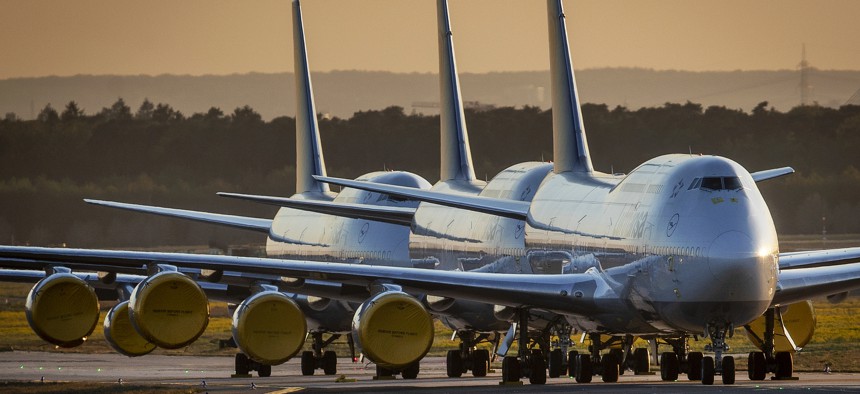
Lufthansa Boeing 747 aircraft parked in Frankfurt due to the coronavirus pandemic. AP Photo/Michael Probst
Boeing’s Coronavirus Losses Now Bleeding Into Its Defense Accounts
More layoffs, production slowdowns and factory closures are being considered, executives said.
Boeing losses from factory closures and production slowdowns caused by the coronavirus pandemic are starting to bleed into the company’s defense projects, according to executives and financial documents.
The company said it would lose $151 million on the KC-46 tanker, bringing Boeing’s total losses on the project to more than $4 billion. Boeing attributed the latest charge to “lower commercial airplane production volume due to COVID-19,” the company said in a statement.
“There was impact on some of the other programs, but it was not really material at all,” Boeing CFO Greg Smith said in a Wednesday conference call with reporters shortly after the company reported its second quarter earnings.
Boeing builds the KC-46 alongside FedEx and UPS 767 cargo freighters. That factory and others in the Seattle area were closed for several weeks in late March and early April as coronavirus infection rates spiked in the Pacific Northwest, where Boeing also builds Navy P-8 submarine hunters and C-40 transports. Both of those planes are militarized versions of the 737.
Smith downplayed the latest tanker charge, saying it was unrelated to the development issues that have long delayed the Air Force from using the planes in combat.
“Performance-wise, the tanker program performed well,” he said. “We didn’t have a reach forward loss associated with performance at all in the quarter. We still got a lot of work to do, but making good progress.”
The sharp drop in passenger air travel amid the coronavirus pandemic has led airlines to cancel or delay orders for new planes, leading to losses for aircraft manufacturers and their suppliers. That, coupled with the nearly year-and-a-half-long grounding of the 737 Max, has led Boeing to cut tens of thousands of workers. More layoffs and factory closures might be needed as the company prepares for an uncertain future, officials said.
Boeing CEO David Calhoun, during a Wednesday morning call with Wall Street analysts, predicted it would take three years until passenger airline travel returned to 2019 levels. That mirrors a similar forecast by his counterpart at Raytheon Technologies on Tuesday.
Things are so bad at Boeing, that the company only delivered 20 airliners in the second quarter. By comparison, business jet maker Gulfstream delivered 32 planes. In the fourth quarter of 2018, before the pandemic and 737 Max grounding, Boeing delivered 238 planes.
The company’s $28.7 billion in revenue for the first half of 2020 is far behind the $38.7 billion it booked in the first half of 2019 and well below the $47.6 billion in the first half of 2018. Earlier this year the company said its defense and space business would make more money than its commercial airliners arm for the first time in more than a decade.
With demand for its planes down, Boeing signaled it could lay off more workers and shut down one of its two 787 Dreamliner production lines. Both are being reviewed by executives. The company said it would slow production of the 777 long-range, widebody airliner and, as was previously expected, stop making the 747 in 2022.
Those decisions call into question the future of Boeing’s sprawling flagship Everett, Washington, widebody assembly factory — the largest building in the world by volume — where the company builds the 747, 767, 777 and 787. Boeing also builds 787s in Charleston, South Carolina, with non-union workers.
Boeing will complete its last 747 airliner — nicknamed “Queen of the Skies” — in 2022. When the Air Force receives its first new Air Force One in 2024, a modified 747, the plane will already be two-years out of production, which could lead to problems getting spare parts. The two current Air Force Ones that were delivered in the early 1990s were among the last 747-200-series planes built. With parts in short supply for that model, the Air Force occasionally needed to raid retired airliners parked in the desert for spares.





